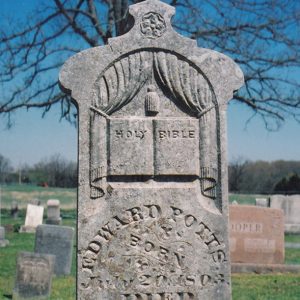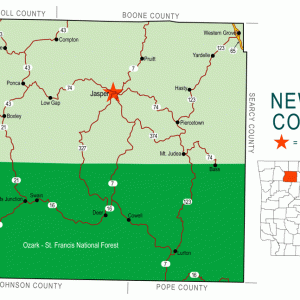calsfoundation@cals.org
Western Grove (Newton County)
| Latitude and Longitude: | 36°06’03″N 092°57’14″W |
| Elevation: | 1,073 feet |
| Area: | 1.08 square miles (2020 Census) |
| Population: | 354 (2020 Census) |
| Incorporation Date: | May 20, 1929 |
Historical Population as per the U.S. Census:
|
1810 |
1820 |
1830 |
1840 |
1850 |
1860 |
1870 |
1880 |
1890 |
1900 |
|
– |
– |
– |
– |
– |
– |
– |
– |
– |
– |
|
1910 |
1920 |
1930 |
1940 |
1950 |
1960 |
1970 |
1980 |
1990 |
2000 |
|
– |
– |
– |
– |
184 |
148 |
179 |
378 |
415 |
407 |
|
2010 |
2020 |
|
|
|
|
|
|
|
|
|
384 |
354 |
|
|
|
|
|
|
|
|
Western Grove is located on U.S. Highway 65 in the northeastern corner of Newton County. Travelers along the highway have made it possible for Western Grove to support a larger number of businesses than is typical of rural towns in the Ozark Mountains region of Arkansas.
Joseph Holcombe was the first to claim land in the area that would become Western Grove. As early roads were developed, the area gained a trading post. The community was originally established before the Civil War under the name of Marshall Prairie. Among the early settlers in the area were William O’Daniel (1849), Edward Potts (1854), and Lewis M. Potts (1861). The post office, established in 1854, was named for postmaster John H. Marshall.
Following the war, the area grew slowly. In 1886, the name of the community and post office was changed to Western Grove. That same year, B. F. Ruble and Ira Marshall opened the Western Grove Academy. They described Western Grove as “a neat little village…surrounded by romantic scenery, good water, healthful climate, and the best of society.” Their schoolhouse was a two-story frame building with two classrooms. It appears, however, that the school did not enroll enough students to complete even the first school year. By 1913, one of the academy’s former students, James Garland Ferguson Sr., had become principal of the public school in Western Grove and re-created the academy for his students. Ferguson, who was a politician, insurance agent, and philanthropist as well as a teacher, held a law degree from the Arkansas Law School in Little Rock (Pulaski County) and served three terms as Arkansas’s Commissioner of Mines, Manufacturers, and Agriculture. However, this academy, too, was short-lived.
Around 1913, the community included a cotton gin, a grist mill, several stores, and several churches. Western Grove incorporated as a town in 1929. By 1949, Western Grove had two general stores, two grocery stores, two cafes, a blacksmith, and a garage for auto repair. Improvements to the highway meant more travel, both for the residents of northern Arkansas and for tourists passing through the area.
By 2013, Western Grove had about fifty businesses and enterprises, including five churches, two trucking businesses, several lumber and construction businesses, a bank, two bed-and-breakfasts, and a head start center. North Pacific Lumber Company and the high school are the town’s largest employers. Western Grove High School is part of the Ozark Mountain School District and has about 100 students; the elementary school has about the same number. Starting in 2023, the district’s seventh through twelfth grades were consolidated at Western Grove. The population of Western Grove in 2010 was 384, predominantly white; that decreased to 354 the following census.
For additional information:
Lackey, Walter F. History of Newton County, Arkansas. N.p.: 1950
———. “History of the Western Grove Academy.” Newton County Homestead 1 (August 1959): 39–40.
Steven Teske
Butler Center for Arkansas Studies
 Nick Miller Carving
Nick Miller Carving  Newton County Map
Newton County Map 



Comments
No comments on this entry yet.